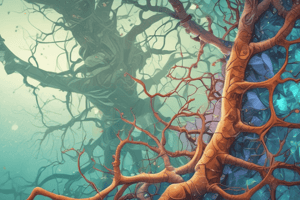Podcast
Questions and Answers
What is the study of the interactions between organisms and their environment?
What is the study of the interactions between organisms and their environment?
- Biochemistry (correct)
- Genetics (correct)
- Microbiology
- Ecology (correct)
What is the primary function of mitochondria in a cell?
What is the primary function of mitochondria in a cell?
- Protein synthesis
- Generate energy for cell (ATP production) (correct)
- Store genetic information (correct)
- Energy storage
Which biological molecule is responsible for storing genetic information?
Which biological molecule is responsible for storing genetic information?
- Carbohydrates
- Nucleic Acids (correct)
- Proteins (correct)
- Lipids (correct)
What is the process by which species adapt to their environment?
What is the process by which species adapt to their environment?
What is the study of the structure, function, and behavior of cells?
What is the study of the structure, function, and behavior of cells?
Test
Test
Flashcards are hidden until you start studying
Study Notes
Branches of Biology
- Botany: study of plants
- Zoology: study of animals
- Microbiology: study of microorganisms (bacteria, viruses, etc.)
- Ecology: study of interactions between organisms and their environment
- Genetics: study of heredity and variation
- Biochemistry: study of chemical processes in living organisms
- Molecular Biology: study of biological molecules and their interactions
- Cell Biology: study of cellular structure, function, and behavior
Biological Molecules
- Carbohydrates: energy source for cells (e.g. sugars, starches)
- Proteins: perform various functions (e.g. enzymes, hormones, structural)
- Lipids: energy storage and structural roles (e.g. fats, oils)
- Nucleic Acids: store genetic information (e.g. DNA, RNA)
Cell Structure
- Plasma Membrane: outermost layer, regulates movement of molecules
- Cytoplasm: jelly-like substance inside cell, site of metabolic reactions
- Nucleus: contains genetic material (DNA)
- Mitochondria: generate energy for cell (ATP production)
- Ribosomes: site of protein synthesis
- Lysosomes: contain digestive enzymes, break down waste
Cellular Processes
- Photosynthesis: light energy converted to chemical energy
- Cell Division: process of cell growth and reproduction (mitosis, meiosis)
- Metabolism: energy conversion and transformation of molecules
- Transport: movement of molecules across cell membrane (passive, active)
- Signaling: communication between cells, response to stimuli
Evolution
- Natural Selection: process by which species adapt to environment
- Speciation: formation of new species
- Phylogeny: study of evolutionary relationships between organisms
- Fossil Record: provides evidence of evolutionary history
Branches of Biology
- Botany is the study of plants
- Zoology is the study of animals
- Microbiology is the study of microorganisms such as bacteria, viruses, and others
- Ecology is the study of interactions between organisms and their environment
- Genetics is the study of heredity and variation
- Biochemistry is the study of chemical processes in living organisms
- Molecular Biology is the study of biological molecules and their interactions
- Cell Biology is the study of cellular structure, function, and behavior
Biological Molecules
- Carbohydrates serve as an energy source for cells and include sugars, starches, and others
- Proteins perform various functions such as enzymes, hormones, and structural roles
- Lipids are responsible for energy storage and structural roles, including fats, oils, and others
- Nucleic Acids, including DNA and RNA, store genetic information
Cell Structure
- The Plasma Membrane is the outermost layer of the cell and regulates the movement of molecules
- Cytoplasm is the jelly-like substance inside the cell where metabolic reactions occur
- The Nucleus contains genetic material in the form of DNA
- Mitochondria generate energy for the cell through ATP production
- Ribosomes are the site of protein synthesis
- Lysosomes contain digestive enzymes and break down waste
Cellular Processes
- Photosynthesis is the process by which light energy is converted to chemical energy
- Cell Division is the process of cell growth and reproduction, including mitosis and meiosis
- Metabolism is the process of energy conversion and transformation of molecules
- Transport refers to the movement of molecules across the cell membrane, including passive and active transport
- Signaling is the process of communication between cells, allowing them to respond to stimuli
Evolution
- Natural Selection is the process by which species adapt to their environment
- Speciation is the formation of new species
- Phylogeny is the study of evolutionary relationships between organisms
- The Fossil Record provides evidence of evolutionary history
Studying That Suits You
Use AI to generate personalized quizzes and flashcards to suit your learning preferences.




